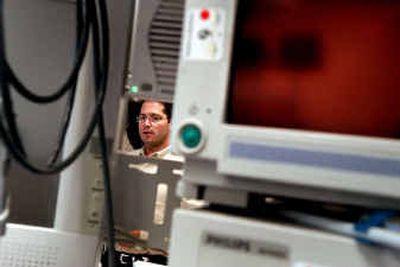Program alive and ticking

Kootenai Medical Center’s new heart program appears to be off the ground.
Actually, the program is three stories tall and has nearly 100 successful open-heart surgeries to its name.
Last week, the Coeur d’Alene hospital’s North Idaho Heart Center opened a $9.6 million facility containing some of the most-advanced heart-care equipment in the region. The building is topped by a helipad and attached to the main part of the hospital.
Doctors and administrators hope the fledgling program’s success and the shiny new facility will stop North Idaho patients from crossing the state line to receive help for their ailing hearts.
“Kootenai Medical Center has spared no expense and cut no corners,” said Dr. Rob Burnett, who was recruited last year from Eugene, Ore., to become North Idaho’s first heart surgeon. “We’re talking the nicest cardiac operating rooms in the Northwest.”
As of Monday, Burnett had operated on 98 hearts since the first operation at Kootenai Medical Center in early September. Once the program crosses the 100-heart mark, the numbers will be scrutinized carefully against national data. Only one patient has died – a complicated case involving a critically ill patient needing bypass surgery and a valve replacement, Burnett said.
Since the first of the year, nearly 500 patients have received balloon angioplasty, wire-mesh stents or diagnostic procedures in the heart center’s catheterization lab. A second lab will be opening in July. The center expects to treat 1,200 patients by the end of the year.
Burnett says the biggest benefit of the new heart center will be in lives saved. Some North Idaho residents have difficulty traveling to Spokane for basic heart care, he said. “If a few more people will get a heart intervention because of this, then it’s worth it.”
The program also is expected to be a financial anchor for the community-owned hospital. An estimated 350 North Idaho residents need open-heart surgery each year, according to information from the hospital. That represents nearly $40 million in potential revenue. Another 2,000 residents’ heart problems are diagnosed or fixed using wire catheters.
The hospital has embarked on an ambitious marketing campaign to highlight the program and convince local residents that new doesn’t necessarily mean inexperienced. Most staff members at the heart center are old hands, said Mike Blee, the center’s director of cardiopulmonary services.
“We aren’t starting from scratch,” he said. “In fact, most of these people started in Spokane.”
Still, it has been a challenge to demonstrate that big-city heart care is possible in Coeur d’Alene. Any mistake could poison the program’s success, Burnett said. “You’re Exhibit A and under the microscope every day. It’s stressful, but I expected everybody to be critical of the program,” he said. “We are up to the task.”
Having a major heart center only 30 miles to the west is a competitive challenge. Spokane continues to receive the sickest, most critical heart patients from North Idaho. Staff members at the North Idaho Heart Center take pains to acknowledge the complexity of the work being done by their colleagues in Spokane while pointing out the subtle differences, such as a new three-dimensional echocardiogram device that allows cardiologists in Coeur d’Alene unprecedented glimpses into the inner workings of the heart.
“We’ve got the only one in the region,” said Blee. “The nearest is in Seattle.”
Apart from the fancy equipment, Burnett says the North Idaho Heart Center has an advantage in being relatively small. In bigger settings, heart surgeons and cardiologists don’t mix much, he said. They often work in separate parts of a hospital. Not so at the North Idaho Heart Center, where Burnett usually is only a few steps away from a cardiologist.
“That ultimately translates into better patient care,” Burnett said. “The decisions are made as a team.”
With the growth of the program and the continued boom in Kootenai County – the emergency room is the first- or second-busiest in Idaho, said Mike Regan, a spokesman for the hospital – parking has become a major concern.
In September, Kootenai Medical Center will begin building a four-story, 392-space parking garage.